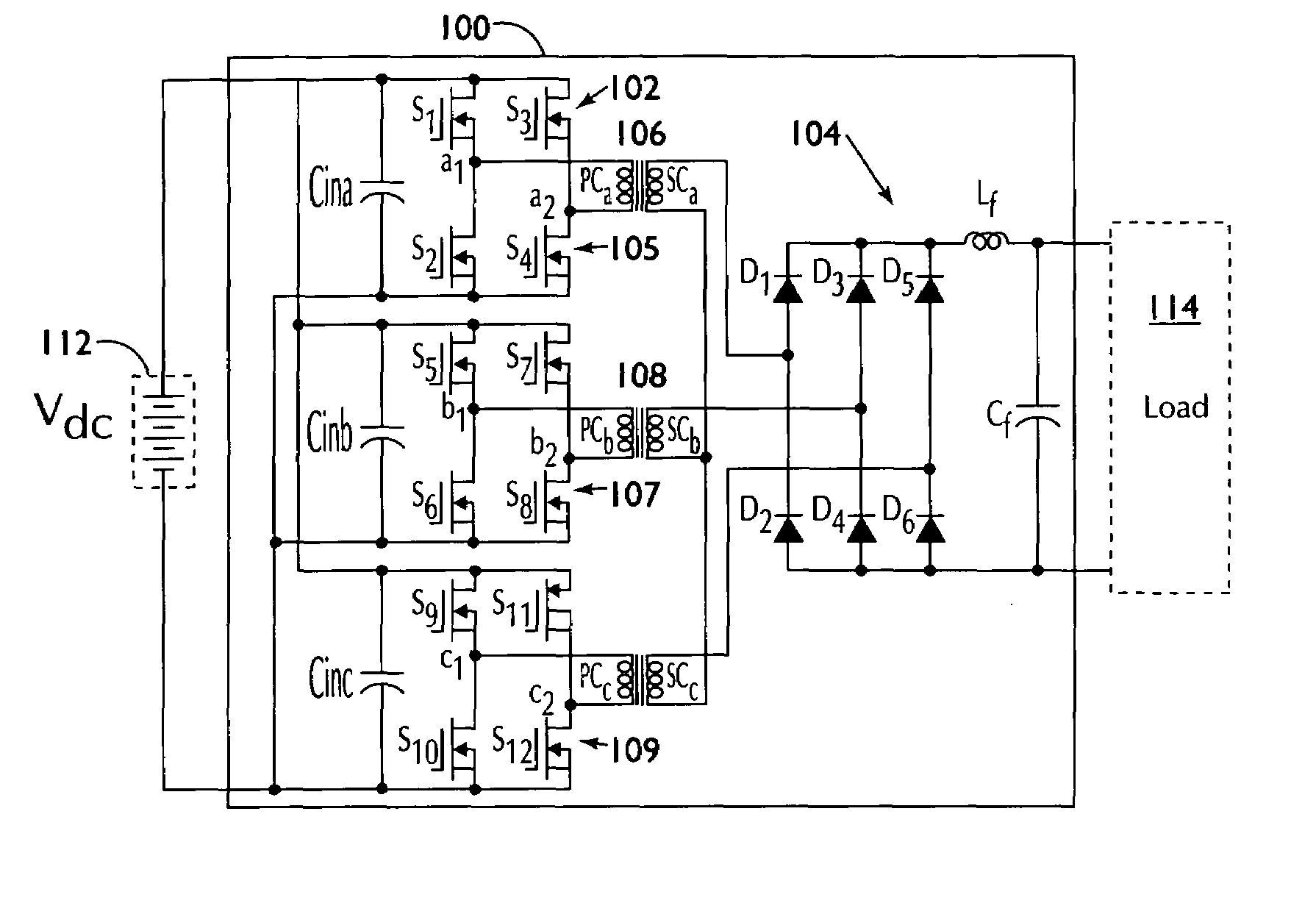Multiphase soft switched DC/DC converter and active control technique for fuel cell ripple current elimination
- Summary
- Abstract
- Description
- Claims
- Application Information
AI Technical Summary
Benefits of technology
Problems solved by technology
Method used
Image
Examples
case 1
[0117] 0°2) is shifted less than 60° (or ⅙ switching period). The gate signals for the upper devices of all 6 legs are shown in FIG. 5a, the filter inductor current in illustrated in FIG. 5b, and the phase output voltages and rectifier output voltage (or filter input voltage) waveforms are illustrated in FIG. 5c. At most one phase transfers DC bus voltage to the output; thus, the maximum ideal voltage is 0. Consequently, the averaged output voltage is:
[0118]Vout_=α60°·n·Vdc.
[0119]The gate signals and inductor current waveforms are shown in FIGS. 5a and 5b. FIG. 5a corresponds to the case 1 switch gate signals. Symbol a1p means the upper switch gate signal of phase leg a1. Similarly, a2p, b1p, b2p, c1p and c2p are the upper switch gate signals of phase leg a2, b1, b2, c1 and c2, respectively. From the timing diagram as an example in mode 0, upper switches a1p, c1p, and c2p are turned on, and three lower switches on phase legs a2, b1, and b2 are turned on. Therefore, phase A is suppl...
case 2
[0132] 60°a-6c show the top-switch gate signals and inductor current waveforms for case 2. The voltage across each transformer primary and the resulting voltage at the output of the rectifier are shown in FIG. 6c. FIG. 6a shows the case 2 switch signals, and FIG. 6c shows the transformer primary voltages and rectifier output for case 2.
[0133]In this case, at least one phase and at most two phases transfer dc bus voltage to the output side. Thus, the ideal maximum voltage transferred to the output is 2n·Vdc, and the minimum voltage is n·Vdc. Through similar analysis as in case 1, the durations for this mode are
[0134]Δt=α-60°60°T
and
[0135]Δt=120°-α60°T,
respectively. In other words, the output voltage is 2n·Vdc for
[0136]Δt=α-60°60°T
and n·Vdc for
[0137]Δt=120°-α60°T.
Therefore, the averaged output voltage can be derived as
[0138]V_out=n·Vdc+α-60°60°·n·Vdc.
Alternatively, the averaged output voltage can be calculated as:
[0139]Vout_=α-60°60°·2n·Vdc+120°-α60°n·Vdc=α6...
case 3
[0140] 120°a-7c shows the upper-switch gate signals and inductor current waveforms for case 3. FIG. 7a shows the switch gate signals for case 3, and FIG. 7c shows the phase output voltages and rectifier output voltage. The voltage across each transformer primary and the resulting voltage at the output of the rectifier are shown in FIG. 7c. Notice how the voltage at the output of the rectifier is constant.
[0141]In this case, at least two phases and at most three phases transfer DC bus voltage to the output side. The output voltage overlaps, thus the ideal voltage transferred to the output is 2n·Vdc at any time, independent of the phase-shift angle α. This also accounts for the filter inductor current being constant for the ideal case. Therefore, the averaged output voltage is uncontrollable and is always equal to Vout=2n·Vdc.
[0142]Since the voltage conversion ratio is fixed, the converter behaves like a transformer, but with DC input / output voltage. Therefore, this mode is defined as...
PUM
 Login to View More
Login to View More Abstract
Description
Claims
Application Information
 Login to View More
Login to View More - R&D
- Intellectual Property
- Life Sciences
- Materials
- Tech Scout
- Unparalleled Data Quality
- Higher Quality Content
- 60% Fewer Hallucinations
Browse by: Latest US Patents, China's latest patents, Technical Efficacy Thesaurus, Application Domain, Technology Topic, Popular Technical Reports.
© 2025 PatSnap. All rights reserved.Legal|Privacy policy|Modern Slavery Act Transparency Statement|Sitemap|About US| Contact US: help@patsnap.com



